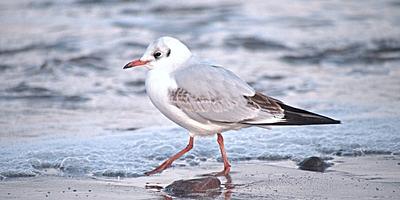
Black-Headed Gull
Chroicocephalus ridibundus
What do they look like?
This small bird is white with a grey mantle (back) and black wingtips. Its legs and slender bill are dark red in spring but duller at other times of the year. In spring and summer the head is dark brown, almost black, which is where the gull gets its name. However, in the winter it loses this dark cap and the head becomes white with black spots behind either eye.
When can I see them in Scotland?
Throughout the year.
Where can I see them in Scotland?
The black-headed gull is found throughout the UK and is particularly common in Scotland. This gull does not only stay by the coast and is often seen inland, being opportunistic in its feeding habits. In the breeding season, the black-headed gull can usually be found in large groups.
Conservation status
In the UK, bird species with breeding, passage or wintering populations are assessed by experts and assigned to Red, Amber or Green lists of conservation concern. Black-headed gulls are currently an ‘AMBER’ listed species.
_Emily_Burton.jpg)
